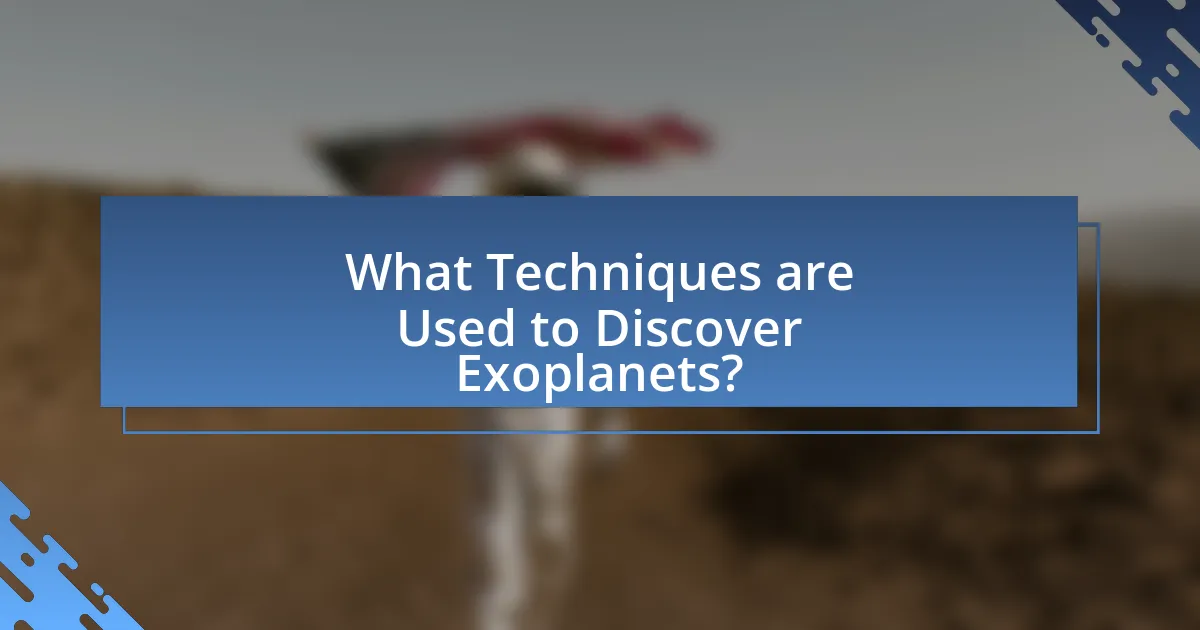Exoplanets, or planets that orbit stars outside our solar system, play a crucial role in expanding our understanding of planetary systems and the potential for extraterrestrial life. As of October 2023, over 5,000 exoplanets have been confirmed, showcasing a diverse array of sizes, compositions, and orbital characteristics. This article explores the differences between exoplanets and those in our solar system, the criteria for their classification, and the significance of their study in understanding the universe. It also examines the challenges faced in exoplanet detection, the various techniques employed, and notable discoveries that have reshaped our knowledge of planetary formation and the search for life beyond Earth.

What are Exoplanets and Why are They Important?
Exoplanets are planets that orbit stars outside our solar system. They are important because they expand our understanding of planetary systems and the potential for life beyond Earth. As of October 2023, over 5,000 exoplanets have been confirmed, revealing a diverse range of sizes, compositions, and orbital characteristics. The study of exoplanets helps scientists investigate the conditions necessary for life, informs models of planetary formation, and enhances our knowledge of the universe’s structure.
How do Exoplanets differ from Planets in Our Solar System?
Exoplanets differ from planets in our solar system primarily in their location; exoplanets orbit stars outside our solar system, while the planets in our solar system orbit the Sun. Exoplanets can vary significantly in size, composition, and orbital characteristics, with some being gas giants similar to Jupiter or Saturn, while others may be rocky like Earth or Mars. The discovery of exoplanets has revealed a diverse range of planetary systems, including those with multiple planets, unusual orbits, and extreme conditions, which contrasts with the relatively stable and predictable arrangement of planets in our solar system. As of October 2023, over 5,000 exoplanets have been confirmed, showcasing a variety of environments and potential for habitability that are not present in our solar system.
What criteria define an Exoplanet?
An exoplanet is defined as a planet that orbits a star outside our solar system. The primary criteria for classifying an exoplanet include its orbital characteristics, such as being in a stable orbit around a star, and its physical properties, which must be planet-like, including sufficient mass to maintain a nearly round shape and not being massive enough to initiate nuclear fusion like a star. According to the International Astronomical Union, an object must have a mass less than 13 times that of Jupiter to be classified as a planet, ensuring it does not fall into the category of brown dwarfs.
Why is the study of Exoplanets significant for understanding the universe?
The study of exoplanets is significant for understanding the universe because it reveals the diversity of planetary systems and the potential for life beyond Earth. Research has shown that there are over 5,000 confirmed exoplanets, indicating that planets are common in the galaxy, which challenges previous assumptions about the uniqueness of our solar system. Additionally, studying the atmospheres and compositions of these exoplanets, such as those found in the TRAPPIST-1 system, provides insights into the conditions that may support life, enhancing our understanding of habitability in the universe.
What are the main challenges in the search for Exoplanets?
The main challenges in the search for exoplanets include the limitations of current detection methods, the vast distances involved, and the interference from stellar light. Current detection methods, such as the transit method and radial velocity technique, often struggle to identify smaller, Earth-like planets due to their subtle signals compared to larger gas giants. The vast distances to exoplanets make it difficult to gather detailed data, as many are located light-years away, complicating observation and analysis. Additionally, the interference from the light of host stars can obscure the signals of orbiting planets, making it challenging to distinguish between the two. These factors collectively hinder the efficiency and accuracy of exoplanet discovery efforts.
How do distance and brightness affect Exoplanet detection?
Distance and brightness significantly influence exoplanet detection by affecting the signal-to-noise ratio of the observations. Closer exoplanets are easier to detect because their light is less diluted by distance, allowing for clearer signals. For instance, the Kepler Space Telescope successfully identified thousands of exoplanets primarily around stars within 3,000 light-years, where brightness levels are sufficient for detection. Conversely, distant exoplanets produce weaker signals, making them harder to distinguish from background noise. Additionally, the brightness of the host star plays a crucial role; brighter stars provide more light, enhancing the chances of detecting transits or other signatures of orbiting exoplanets. Studies show that exoplanets around bright stars are detected more frequently, as seen in the TESS mission, which targets bright stars to maximize detection efficiency.
What technological limitations hinder Exoplanet research?
Technological limitations that hinder exoplanet research include insufficient sensitivity of current telescopes, limited spectral resolution, and challenges in detecting faint signals against the brightness of stars. Current ground-based and space-based telescopes, such as the Kepler Space Telescope, struggle to detect smaller, Earth-sized exoplanets due to their faintness and the overwhelming light from their host stars. For instance, the ability to discern the transit of an exoplanet requires precise measurements of stellar brightness, which is often compromised by atmospheric turbulence and light pollution. Additionally, the spectral resolution needed to analyze the atmospheres of exoplanets is often inadequate, limiting the identification of chemical signatures that indicate habitability. These technological constraints significantly impact the efficiency and accuracy of exoplanet detection and characterization.

What Techniques are Used to Discover Exoplanets?
The primary techniques used to discover exoplanets include the transit method, radial velocity method, direct imaging, and gravitational microlensing. The transit method detects exoplanets by observing the dimming of a star’s light as a planet passes in front of it, with NASA’s Kepler mission identifying over 2,300 confirmed exoplanets using this technique. The radial velocity method measures variations in a star’s spectrum due to the gravitational pull of an orbiting planet, providing evidence of its presence; this method has been instrumental in discovering many of the first exoplanets. Direct imaging captures images of exoplanets by blocking out the star’s light, allowing for the study of their atmospheres and compositions. Gravitational microlensing occurs when a massive object, like a star, magnifies the light of a more distant star, revealing the presence of planets around the foreground star. Each of these techniques has contributed significantly to our understanding of exoplanets and their characteristics.
How does the Transit Method work in Exoplanet detection?
The Transit Method detects exoplanets by observing the periodic dimming of a star’s light as a planet passes in front of it. This dimming occurs because the planet blocks a portion of the star’s light, leading to a measurable decrease in brightness. The method relies on precise photometric measurements to identify these small changes in brightness, which can indicate the presence of a planet. For instance, the Kepler Space Telescope utilized this technique to discover thousands of exoplanets by monitoring the brightness of over 150,000 stars for variations that suggest transits.
What are the advantages and limitations of the Transit Method?
The Transit Method offers significant advantages and notable limitations in the search for exoplanets. One primary advantage is its ability to detect small planets, including Earth-sized ones, by measuring the dimming of a star’s light as a planet passes in front of it, which allows for the estimation of the planet’s size and orbital period. This method has led to the discovery of thousands of exoplanets, including those in the habitable zone of their stars, as evidenced by data from NASA’s Kepler mission, which identified over 2,300 confirmed exoplanets.
However, the limitations of the Transit Method include its reliance on the alignment of the planet’s orbit with the observer’s line of sight, which means that only a fraction of planets will be detectable using this method. Additionally, it cannot provide direct information about the planet’s atmosphere or surface conditions without further observational techniques. This limitation is highlighted by the fact that many potentially habitable planets may not transit their host stars from our perspective, thus remaining undetected.
How has the Transit Method contributed to major discoveries?
The Transit Method has significantly contributed to major discoveries by enabling the detection of thousands of exoplanets, including those in the habitable zone. This technique measures the dimming of a star’s light as a planet passes in front of it, allowing astronomers to infer the planet’s size and orbital period. For instance, NASA’s Kepler Space Telescope utilized the Transit Method to identify over 2,300 confirmed exoplanets and thousands of additional candidates, fundamentally expanding our understanding of planetary systems beyond our own. This method has also led to the discovery of Earth-sized planets in the habitable zone, such as Kepler-186f, which is crucial for the search for extraterrestrial life.
What is the Radial Velocity Method and how does it function?
The Radial Velocity Method is an astronomical technique used to detect exoplanets by measuring the changes in the velocity of a star due to the gravitational influence of an orbiting planet. This method functions by observing the Doppler effect, where the light from a star shifts in wavelength as it moves towards or away from Earth. When a planet orbits a star, it causes the star to wobble slightly, resulting in periodic shifts in the star’s spectral lines. These shifts can be quantified to determine the presence of a planet, its mass, and its orbital characteristics. The method has been instrumental in discovering numerous exoplanets, with over 700 confirmed detections attributed to this technique, demonstrating its effectiveness in the search for planets beyond our solar system.
What are the key factors that influence the Radial Velocity Method’s effectiveness?
The key factors that influence the Radial Velocity Method’s effectiveness include the precision of the spectroscopic measurements, the stability of the observing environment, and the characteristics of the target star. High-precision spectrometers, capable of detecting minute changes in a star’s spectral lines, are essential for identifying the small shifts caused by orbiting planets. Additionally, a stable observing environment minimizes noise and variability, enhancing measurement accuracy. The target star’s characteristics, such as its mass, luminosity, and activity level, also play a crucial role; for instance, more massive and less active stars provide clearer signals, making it easier to detect the radial velocity variations induced by planets.
How has this method changed our understanding of planetary systems?
The method of transit photometry has significantly enhanced our understanding of planetary systems by allowing astronomers to detect exoplanets through the measurement of dimming in a star’s light as a planet passes in front of it. This technique has led to the discovery of thousands of exoplanets, revealing a diverse range of planetary types and orbits, which challenges previous models of planetary formation and distribution. For instance, the Kepler Space Telescope, utilizing this method, identified over 2,300 confirmed exoplanets, demonstrating that smaller, Earth-like planets are more common than previously thought. This evidence has reshaped theories regarding the potential for life beyond our solar system and the dynamics of planetary systems.
What role do Direct Imaging and Gravitational Microlensing play in Exoplanet discovery?
Direct Imaging and Gravitational Microlensing are crucial techniques in the discovery of exoplanets. Direct Imaging allows astronomers to capture images of exoplanets by blocking out the light from their host stars, enabling the observation of planets that are otherwise obscured. This method has successfully identified several exoplanets, including the directly imaged planet HR 8799 b, which was observed in 2008.
Gravitational Microlensing, on the other hand, detects exoplanets by observing the light from a distant star that is temporarily magnified by the gravitational field of a foreground star and its planets. This technique has led to the discovery of numerous exoplanets, including those in the OGLE (Optical Gravitational Lensing Experiment) survey, which has identified thousands of potential exoplanets since its inception in 1992. Both methods contribute significantly to expanding our understanding of planetary systems beyond our own.
How does Direct Imaging help in studying Exoplanet atmospheres?
Direct imaging aids in studying exoplanet atmospheres by allowing astronomers to capture light directly from the planets, enabling the analysis of their atmospheric composition. This technique utilizes advanced telescopes equipped with coronagraphs or starshades to block out the light from the host star, thereby isolating the light from the exoplanet. By examining the spectrum of this light, scientists can identify specific molecular signatures, such as water vapor, carbon dioxide, and methane, which are crucial for understanding the atmospheric conditions and potential habitability of the exoplanet. For instance, the Hubble Space Telescope and the upcoming James Webb Space Telescope are designed to perform such observations, providing valuable data that enhances our knowledge of exoplanet atmospheres.
What are the unique advantages of Gravitational Microlensing?
Gravitational microlensing offers unique advantages in the search for exoplanets by enabling the detection of planets that are otherwise too faint to observe directly. This technique allows astronomers to identify the presence of exoplanets through the gravitational effects they exert on light from distant stars, which can reveal the planets’ existence even when they are not visible. For instance, the discovery of the exoplanet OGLE-2005-BLG-390Lb was made possible through gravitational microlensing, demonstrating its effectiveness in identifying planets in the Milky Way that are not detectable by traditional methods. Additionally, gravitational microlensing can probe a wide range of distances and masses, making it a versatile tool for studying both small and large exoplanets across various environments.

What Notable Discoveries Have Been Made in the Search for Exoplanets?
Notable discoveries in the search for exoplanets include the detection of the first confirmed exoplanet, 51 Pegasi b, in 1995, which was identified using the radial velocity method. This discovery marked a significant milestone in astronomy, leading to the identification of thousands of exoplanets since then. The Kepler Space Telescope, launched in 2009, has been instrumental in discovering over 2,600 confirmed exoplanets by employing the transit method, which detects dips in starlight caused by planets passing in front of their host stars. Additionally, the discovery of potentially habitable exoplanets, such as Proxima Centauri b in 2016, has sparked interest in the search for extraterrestrial life. The advancements in technology and methods, including direct imaging and gravitational microlensing, have further expanded our understanding of exoplanetary systems.
What are some of the most significant Exoplanets discovered to date?
Some of the most significant exoplanets discovered to date include Kepler-186f, Proxima Centauri b, and TRAPPIST-1e. Kepler-186f, identified by NASA’s Kepler mission in 2014, is notable for being the first Earth-sized exoplanet found in the habitable zone of another star, indicating potential for liquid water. Proxima Centauri b, discovered in 2016, orbits the closest star to the Sun and lies within its habitable zone, raising interest in the possibility of life. TRAPPIST-1e, part of a system with seven Earth-sized planets discovered in 2017, is significant due to its location in the habitable zone of its star, suggesting conditions that could support life. These discoveries have advanced our understanding of planetary systems and the potential for life beyond Earth.
How do these discoveries challenge our understanding of planetary formation?
Recent discoveries of exoplanets, particularly those that are significantly larger than Jupiter or orbiting their stars at close distances, challenge the traditional models of planetary formation. These findings suggest that the processes of accretion and migration may be more complex than previously understood, indicating that gas giants can form in environments that were thought to be unsuitable for such large bodies. For instance, the detection of hot Jupiters, which are gas giants located very close to their stars, contradicts the notion that these planets can only form far from their stellar hosts and migrate inward later. This evidence necessitates a reevaluation of the mechanisms driving planetary formation and migration, highlighting the need for new theoretical frameworks to account for the diversity of planetary systems observed.
What implications do these discoveries have for the search for extraterrestrial life?
Recent discoveries of exoplanets, particularly those in the habitable zone, significantly enhance the search for extraterrestrial life by identifying environments where conditions may support life. For instance, the detection of water vapor in the atmospheres of exoplanets like K2-18b suggests the potential for liquid water, a crucial ingredient for life as we know it. Additionally, advancements in detection techniques, such as the transit method and direct imaging, allow astronomers to analyze the chemical compositions of these planets’ atmospheres, increasing the likelihood of finding biosignatures. These findings underscore the importance of targeted missions, such as the James Webb Space Telescope, which aims to study the atmospheres of potentially habitable exoplanets in greater detail, thereby refining our understanding of where life might exist beyond Earth.
How have advancements in technology influenced Exoplanet discoveries?
Advancements in technology have significantly enhanced the discovery of exoplanets by improving detection methods and data analysis capabilities. For instance, the development of space telescopes like Kepler and TESS has enabled astronomers to identify thousands of exoplanets through the transit method, which detects dips in starlight caused by planets passing in front of their host stars. Additionally, advancements in spectroscopy allow scientists to analyze the atmospheres of these planets, revealing their composition and potential habitability. The precision of these technologies has led to the confirmation of over 5,000 exoplanets as of 2023, showcasing the direct impact of technological progress on our understanding of planetary systems beyond our own.
What new instruments are being developed for Exoplanet research?
New instruments being developed for exoplanet research include the James Webb Space Telescope (JWST), the Extremely Large Telescope (ELT), and the Ariel mission. The JWST, launched in December 2021, is designed to observe the atmospheres of exoplanets and detect chemical signatures indicative of life. The ELT, expected to be operational in the late 2020s, will utilize its large aperture to directly image exoplanets and analyze their compositions. The Ariel mission, set to launch in 2029, aims to study the atmospheres of a wide range of exoplanets, providing insights into their formation and evolution. These instruments represent significant advancements in technology, enhancing our ability to explore and understand distant worlds.
How do space telescopes enhance our ability to find Exoplanets?
Space telescopes enhance our ability to find exoplanets by providing unobstructed views of the universe, free from Earth’s atmospheric interference. This clarity allows for more precise measurements of light from distant stars, enabling the detection of slight dimming caused by orbiting planets, a method known as the transit method. For instance, NASA’s Kepler Space Telescope, launched in 2009, identified over 2,600 confirmed exoplanets by monitoring the brightness of more than 150,000 stars. Additionally, space telescopes can observe a broader spectrum of light, including infrared, which helps in identifying the chemical compositions of exoplanet atmospheres, further refining our understanding of these distant worlds.
What are the future prospects for Exoplanet research?
The future prospects for exoplanet research are highly promising, driven by advancements in technology and observational techniques. Upcoming missions, such as the James Webb Space Telescope, are expected to provide unprecedented data on exoplanet atmospheres, enabling the detection of potential biosignatures. Additionally, the continued development of ground-based observatories and space missions will enhance our ability to discover and characterize a diverse range of exoplanets, including Earth-like candidates in habitable zones. The increasing collaboration among international space agencies and research institutions further supports the expansion of knowledge in this field, as evidenced by the successful detection of over 5,000 confirmed exoplanets to date.
How might upcoming missions change our understanding of Exoplanets?
Upcoming missions, such as the James Webb Space Telescope and the European Space Agency’s Ariel mission, are poised to significantly enhance our understanding of exoplanets by providing unprecedented observational capabilities. These missions will enable scientists to analyze the atmospheres of exoplanets in detail, allowing for the detection of chemical signatures indicative of habitability or biological processes. For instance, the James Webb Space Telescope can observe infrared wavelengths, which are crucial for identifying molecules like water vapor, carbon dioxide, and methane in exoplanetary atmospheres. This capability is expected to lead to breakthroughs in identifying potentially habitable worlds and understanding their formation and evolution.
What are the potential breakthroughs we can expect in the next decade?
In the next decade, we can expect significant breakthroughs in the search for exoplanets, particularly through advancements in space-based telescopes and improved detection methods. The James Webb Space Telescope, launched in 2021, is anticipated to provide unprecedented data on exoplanet atmospheres, enabling scientists to identify potential biosignatures. Additionally, the development of the Extremely Large Telescope, set to begin operations in the mid-2020s, will enhance our ability to directly image exoplanets and analyze their compositions. These technological advancements are expected to lead to the discovery of Earth-like planets in habitable zones around stars, expanding our understanding of planetary systems and the potential for extraterrestrial life.
What practical tips can be applied to engage with Exoplanet research?
To engage with exoplanet research, individuals can participate in citizen science projects such as Planet Hunters, where volunteers analyze data from telescopes to identify potential exoplanets. This method has proven effective, as over 1,000 exoplanets have been confirmed through similar collaborative efforts. Additionally, attending lectures, workshops, and conferences focused on exoplanet studies can enhance understanding and foster connections with professionals in the field. Engaging with online platforms and forums dedicated to astronomy can also provide valuable insights and updates on the latest discoveries and techniques in exoplanet research.


